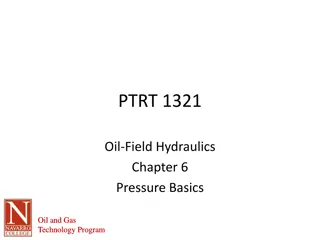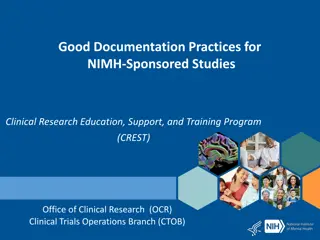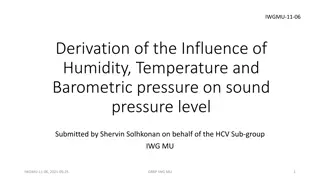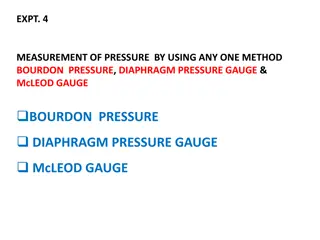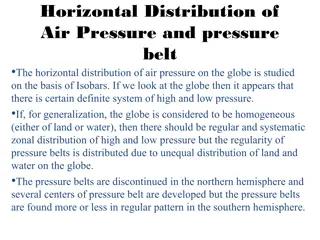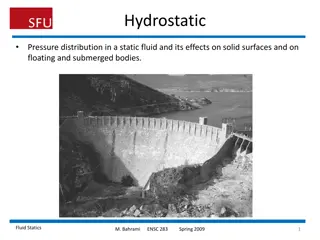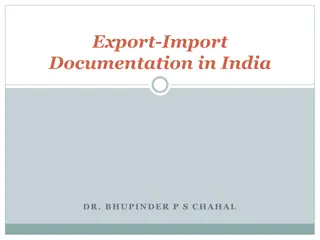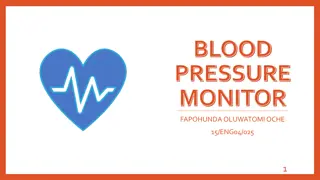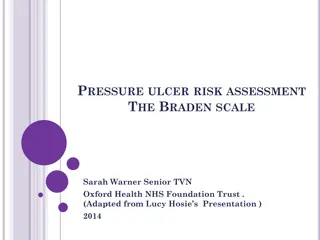Documentation Tips: Pressure Ulcers
Understanding the risk factors and implementing preventive measures is crucial in avoiding pressure ulcers. Proper documentation enables effective monitoring and ensures timely intervention. Learn the tips to maintain skin integrity, relieve pressure, and promote overall wellness to prevent the development of pressure ulcers. By adhering to these strategies, healthcare professionals can significantly reduce the incidence of pressure ulcers among vulnerable individuals. Stay informed and proactive to provide optimal care and enhance patient outcomes.
Download Presentation

Please find below an Image/Link to download the presentation.
The content on the website is provided AS IS for your information and personal use only. It may not be sold, licensed, or shared on other websites without obtaining consent from the author.If you encounter any issues during the download, it is possible that the publisher has removed the file from their server.
You are allowed to download the files provided on this website for personal or commercial use, subject to the condition that they are used lawfully. All files are the property of their respective owners.
The content on the website is provided AS IS for your information and personal use only. It may not be sold, licensed, or shared on other websites without obtaining consent from the author.
E N D
Presentation Transcript
Documentation Tips: Pressure Ulcer
Penny & Quality For Your Thoughts Penny & Quality For Your Thoughts Pressure ulcer or Decubitus ulcer A pressure ulcer is a localized injury to the skin and/or underlying tissue usually over a bony prominence, as a result of pressure, or pressure in combination with shear. Stage ( Stage I, Stage II, Stage III, Stage IV, Unstageable, DTPI(deep tissue pressure injury), see slides 7 to 9 for details. Common Locations (sacrum/coccyx, hip, heel, buttocks, low back, elbow, shoulder) Present on admission
Clinical Example Clinical Example Mr. Cooper Mr. Cooper HPI: 90 y Male from SNF, h/o CVA in 2016 with left hemiparesis and vascular dementia, presents with increasing purulent drainage from sacral pressure ulcer stage III and reported Temp of 102.5F at the SNF. P/E: Temp= 102F BP = 92/62 mm Hg, HR = 120 RR =23 Lab: WBC= 18.6 Lactic acid = 2.8 Cr 1.8 from baseline 1.2 Blood and sacral wound cultures returned positive for MRSA. Rx: IV Vancomycin, IV Fluids, Wound care
Documentation Impact Documentation Impact POOR GOOD Sepsis due to MRSA bacteremia and infected sacral pressure ulcer stage III, present on admission (PDx/MCC) Acute kidney failure or acute renal failure or acute kidney injury (CC) Left hemiparesis s/p CVA in 2016 (CC) Vascular Dementia s/p CVA in 2016 Sepsis DQ ulcer Decub ulcer Sacral wound Sacral Pressure ulcer MRSA Bacteremia Expected Length of Stay = 4.9 Days Expected Length of Stay = 3.7 Days
Pressure Ulcer Documentation Best Practice Pressure Ulcer Documentation Best Practice ALWAYS DOCUMENT: Type of Ulcer (pressure or decubitus) Location and Laterality ( ex. Right heel, Right elbow, sacrum) Stage (DTPI, Stage I, Stage II, Stage III, Stage IV, Unstageable) Present on admission QI Web Site: qualityindicators.ahrq.gov (PRESSURE ULCER IS A PATIENT SAFETY INDICATOR #3) The Patient Safety Indicators (PSIs) are a set of indicators providing information on potential in hospital complications and adverse events following surgeries, procedures, and childbirth PSIs can be used to help hospitals identify potential adverse events that might need further study; provide the opportunity to assess the incidence of adverse events and in hospital complications using administrative data found in the typical discharge record; include indicators for complications occurring in hospital that may represent patient safety events; and, indicators also have area level analogs designed to detect patient safety events on a regional level
Key Points Key Points Nursing documentation of pressure ulcer or wounds can be found from: Wound nurse notes, or Nursing flowsheet adult patient care summary section skin
Pressure Ulcer Stages/Categories Pressure Ulcer Stages/Categories (National Pressure Ulcer Advisory Panel) (National Pressure Ulcer Advisory Panel) www.npuap.org www.npuap.org Deep Tissue Pressure Injury Persistent non-blanchable deep red, maroon or purple discoloration. Intact or non-intact skin with localized area of persistent non-blanchable deep red, maroon, purple discoloration or epidermal separation revealing a dark wound bed or blood filled blister. Pain and temperature change often precede skin color changes. Discoloration may appear differently in darkly pigmented skin. This injury results from intense and/or prolonged pressure and shear forces at the bone-muscle interface. The wound may evolve rapidly to reveal the actual extent of tissue injury, or may resolve without tissue loss. If necrotic tissue, subcutaneous tissue, granulation tissue, fascia, muscle or other underlying structures are visible, this indicates a full thickness pressure injury (Unstageable, Stage 3 or Stage 4). Do not use DTPI to describe vascular, traumatic, neuropathic, or dermatologic conditions. Unstageable Pressure Injury Obscured full-thickness skin and tissue loss Full-thickness skin and tissue loss in which the extent of tissue damage within the ulcer cannot be confirmed because it is obscured by slough or eschar. If slough or eschar is removed, a Stage 3 or Stage 4 pressure injury will be revealed. Stable eschar (i.e. dry, adherent, intact without erythema or fluctuance) on the heel or ischemic limb should not be softened or removed.
Pressure Ulcer Stages/Categories Continued Pressure Ulcer Stages/Categories Continued Stage I: Non-blanchable erythema of intact skin Stage II: Partial-thickness skin loss with exposed dermis Partial-thickness loss of skin with exposed dermis. The wound bed is viable, pink or red, moist, and may also present as an intact or ruptured serum- filled blister. Adipose (fat) is not visible and deeper tissues are not visible. Granulation tissue, slough and eschar are not present. These injuries commonly result from adverse microclimate and shear in the skin over the pelvis and shear in the heel. This stage should not be used to describe moisture associated skin damage (MASD) including incontinence associated dermatitis (IAD), intertriginous dermatitis (ITD), medical adhesive related skin injury (MARSI), or traumatic wounds (skin tears, burns, abrasions). Intact skin with a localized area of non-blanchable erythema, which may appear differently in darkly pigmented skin. Presence of blanchable erythema or changes in sensation, temperature, or firmness may precede visual changes. Color changes do not include purple or maroon discoloration; these may indicate deep tissue pressure injury.
Pressure Ulcer Stages/Categories Continued Pressure Ulcer Stages/Categories Continued Stage III: Full-thickness skin loss Stage IV: Full-thickness skin and tissue loss Full-thickness loss of skin, in which adipose (fat) is visible in the ulcer and granulation tissue and epibole (rolled wound edges) are often present. Slough and/or eschar may be visible. The depth of tissue damage varies by anatomical location; areas of significant adiposity can develop deep wounds. Undermining and tunneling may occur. Fascia, muscle, tendon, ligament, cartilage and/or bone are not exposed. If slough or eschar obscures the extent of tissue loss this is an Unstageable Pressure Injury. Full-thickness skin and tissue loss with exposed or directly palpable fascia, muscle, tendon, ligament, cartilage or bone in the ulcer. Slough and/or eschar may be visible. Epibole (rolled edges), undermining and/or tunneling often occur. Depth varies by anatomical location. If slough or eschar obscures the extent of tissue loss this is an Unstageable Pressure Injury. Reference: www.npuap.org NPUAP Pressure Injury Stages NPUAP Position Statement on Staging 2017 Clarifications , January 24, 2017





